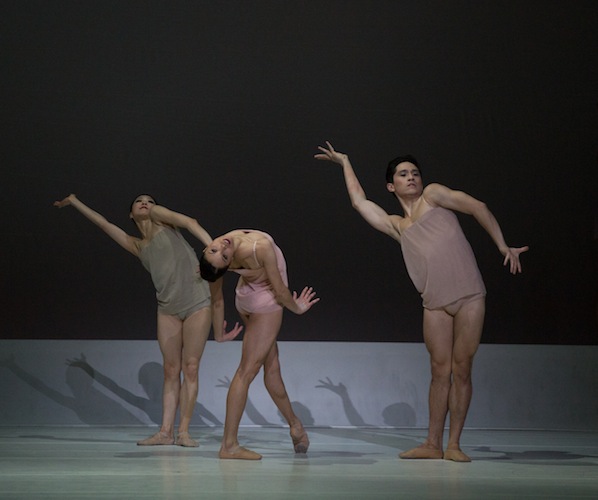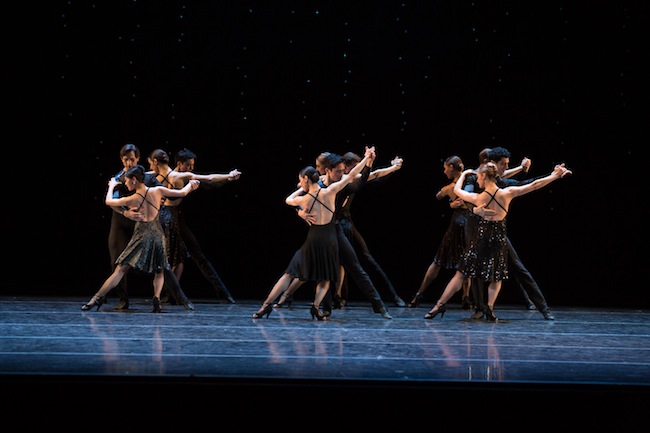Dance Review: Boston Ballet’s “Shades of Sound” — Energetic Versatility
Each piece is so different from the others in Shades of Sound that the evening provides something for everyone, giving the company a chance to showcase its phenomenal technique.
Shades of Sound, staged by the Boston Ballet at the Boston Opera House, Boston, MA, through March 29.

Boston Ballet’s Misa Kuranaga, Lia Cirio, and Jeff Cirio in Wayne McGregor’s “Chroma.” Photo: Rosalie O’Connor.
By Merli V. Guerra
Shades of Sound, Boston Ballet’s latest production, offers audiences a dynamic range of athleticism, technique, and comedic skill. The evening features three works: Wayne McGregor’s Chroma, George Balanchine’s Episodes, and Hans van Manen’s Black Cake. Each piece is so different from the others that the evening provides something for everyone, giving the company a chance to showcase its phenomenal technique.
Chroma opens with a brilliantly gleaming set that is striking in its simplicity. The dancers stand in the foreground of a floor-to-ceiling white wall with a large cutout that creates the three-dimensional effect of a shadow box. Throughout the work, the set provides a somewhat sterile, yet intriguingly versatile, companion to the choreography, the backdrop generating moments of intense color and depth, creating alternate perceptions of space that shift according to the particular dancers on stage.
The piece, set to live orchestrations of the pleasingly-atypical (for ballet) scores of Joby Talbot and Jack White, begins fretfully. A solo dancer coils and flails against the physical contact of her male counterpart. Yet, as the two disband and others join the tumultuous discord, we quickly learn that we should view each dancer as a genderless individual. The company is further homogenized by minimal costuming, as if the dancers are specks of paint, in a neutral palette, splattering across a canvas.
Though stunning in its technical athleticism and creative partnering, the piece initially offers little emotional context to justify its furious motions, keeping the viewer at arm’s length. Why this fretful energy? Why these seemingly unrelated pairings? As a result, the work is a bit off-putting until nearly halfway through. Yet when it does become compelling it’s hard to look back.
McGregor shifts pace with a male trio that is absolutely mesmerizing in its intricate fluidity. The three move as if an unseen juggler has sent them spiraling into motion, with the men twisting, gliding, and lifting one another in an endless wave of momentum. This energizing segment is followed by a contrastingly calm duet that is breathtaking in its series of quiet, deliberate gestures and lifts. Ultimately, Chroma ends in a satisfying cacophony of limbs and synergy that it difficult to forget.

Boston Ballet in George Balanchine’s Episodes © The George Balanchine Trust. Photo: Rosalie O’Connor.
Up next is Balanchine’s classic Episodes, which first premiered back in 1959. This work draws one’s focus back to Boston Ballet’s mastery of clean lines and impressive precision. In this piece, Balanchine gives the audience a peek behind-the-scenes, a sort of rehearsal view. Dressed in traditional classroom attire, the dancers move through their rote motions stoically, as if they were training with only a ballet master’s eyes watching them rather than a full opera house of viewers. Everything feels preparatory, with even the music (selections from the works of Anton von Webern) reminiscent of an orchestra tuning and preparing for the big night.
Episodes steps away from the seminar room for a moment, the lighting and costuming suggesting that the scene is now a feature stage. Dusty Button and Lasha Khozashvili dance marvelously together, each proving to be quite the charismatic performer. Staggering towards each other in the dark, the two meet in the middle of the stage and creatively intertwine — a relationship commences. Delightful oddities, such as a deliberately placed flexed foot here, and the brief flicker of a smoked cigarette there, add to the psychological complexities provided by this mysterious duo.
Yet as the turbulent scene closes, we are once again back in the staid studio, coming full circle in the life of a dancer. Always working, pushing, refining for that one brief moment of emotional freedom through dance on the main stage, before returning to the studio to once again work, push, and refine.

Boston Ballet in Hans van Manen’s “Black Cake.” Photo: Rosalie O’Connor.
In contrast to the two pieces before it, Black Cake offers audiences the first narrative of the evening with delineated characterizations. The audience giggles as the dancers saunter on stage, obviously preparing for a high-society cocktail party, each sporting sleek black attire, primping while they zip or button up their glamorous garments. In truth, the piece’s slapstick jokes and pantomime runs amuck, though clever pairings and moments of surprising sincerity bring it back to reality.
Eventually we are peering in through a window to catch a glimpse of this marvelous party, dresses and belt buckles glistening beneath a star-speckled sky. The six couples—now confident in their stride, unlike their previous nervous preparation — march two by two across the dance floor, each mimicking the next as the ballroom-esque number builds. This scene could benefit from some trimming: the tedious repetition of the introductions diminish the work’s overarching tension. Yet mixed in with the “Dancing With the Stars” sashaying are moment of zesty comedy, as the dancers—taking themselves oh-so-seriously—lunge across the stage in a humorously unattractive waltz.
After a series of duets, ranging from one that is beautiful in its fluidity to another that is intentionally marred by some over-the-top farce moves, the cast reconvenes for a drinking scene that truly “takes the cake.” Audience members laugh aloud, first at the dancers’ drunken revelry, then at their evident despair as a new tray of champagne passes them by. For better or worse, this final scene will leave you wanting more, only to have the show, like a bar at 1 a.m., close.
Merli V. Guerra is a professional dancer with a background in ballet, modern, and classical Indian dance in the Odissi style, and an award-winning interdisciplinary artist with talents in choreography, filmmaking, writing, and graphic design. She is co-founder and artistic director of Luminarium Dance Company, production manager of Art New England magazine in Boston, and selects The Arts Fuse’s weekly coming attractions for dance.
Tagged: Black Cake, Boston-Ballet, Chroma, Episodes, George Balanchine, Hans van Manen, Merli V. Guerra, Shades of Sound
